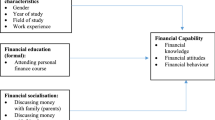Abstract
This study investigates the impact of personal finance education delivered in high school and college. Outcomes of interest were investment knowledge and household savings rates measured years after the financial education was delivered. A web-based survey with questions about participation in financial education, financial experiences, income and inheritances, and demographic characteristics was administered to 1,039 alumni from a large midwestern university. Participation in a college level personal finance course was associated with higher levels of investment knowledge. Experience with financial instruments appeared to explain more of the variance in both investment knowledge and savings rates. No significant relationship between taking a high school course and investment knowledge was found. Financial experiences were found to be positively associated with savings rates.
Similar content being viewed by others
References
American Savings Education Council (2001). Parents, youth & money survey. Washington, DC: American Savings Education Council.
Bernheim, D. B., Garrett, D. M., & Maki, D. M. (2001). Education and saving: The long-term effects of high school financial curriculum mandates. Journal of Public Economics, 80(3), 435–465.
Chen, H., & Volpe, R. P. (1998). An analysis of personal financial literacy among college students. Financial Services Review, 7(2), 107–128.
Danes, S. M., Huddleston-Casas, C., & Boyce, L. (1999). Financial planning curriculum for teens: Impact evaluation. Financial Counseling and Planning, 10(1), 25–37.
Dhar, R., & Zhu, N. (2006). Up close and personal: Investor sophistication and the disposition effect. Management Science, 52(5), 726–740.
Fox, J., & Bartholomae, S. (1999). Student learning style and educational outcomes: Evidence from a family financial management course. Financial Services Review, 8(4), 235–251.
Hayhoe, C. R., Leach, L. J., Turner, P. R., Bruin, M. J., & Lawrence, F. C. (2000). Indifferences in spending habits and credit use of college students. The Journal of Consumer Affairs, 34(1), 113–133.
Hira, T. K., & Loibl, C. (2005). A gender perspective on the use of supplemental healthcare plans. International Journal of Consumer Studies, 29(4), 319–331.
Huddleston, C. A., Danes, S. M., & Boyce, L. (1999). Impact evaluation of a financial literacy program: Evidence for needed educational policy changes. Consumer Interests Annual, 45, 109–114.
Kolb, D. (1984). Experiential learning: Experience as the source of learning and development. Englewood Cliffs, NJ: Prentice Hall.
Langrehr, F. W. (1979). Consumer education: Does it change students’ competencies and attitudes? The Journal of Consumer Affairs, 13(1), 41–53.
Mandell, L. (1998). Our vulnerable youth: The financial literacy of American 12th graders. Washington, DC: Jump$tart Coalition for Personal Financial Literacy.
Mandell, L. (2004). Financial literacy: Are we improving? Washington, DC: Jump$tart Coalition for Personal Financial Literacy.
Moschis, G. P., & Churchill, G. A. (1978). Consumer socialization: A theoretical and empirical analysis. Journal of Marketing Research, 15(4), 599–609.
National Association of Securities Dealers & Applied Research and Consulting LLC (2003). NASD investor literacy research. Retrieved December 20, 2006, from http://www.nasdfoundation.org/surveyexecsum.pdf.
National Council on Economic Education (2005). Survey of the states: Economic and personal finance education in our nation’s schools in 2004. New York: NCEE.
National Endowment for Financial Education (1998). Evaluation of the NEFE high school financial planning program 1997–1998. Englewood, CO: Boyce, L. & Danes, S. M.
Tennyson, S., & Nguyen, C. (2001). State curriculum mandates and student knowledge of personal finance. The Journal of Consumer Affairs, 35(2), 241–262.
Author information
Authors and Affiliations
Corresponding author
Appendix
Appendix
Ten-item NASD investment knowledge test
Rights and permissions
About this article
Cite this article
Peng, TC.M., Bartholomae, S., Fox, J.J. et al. The Impact of Personal Finance Education Delivered in High School and College Courses . J Fam Econ Iss 28, 265–284 (2007). https://doi.org/10.1007/s10834-007-9058-7
Published:
Issue Date:
DOI: https://doi.org/10.1007/s10834-007-9058-7




